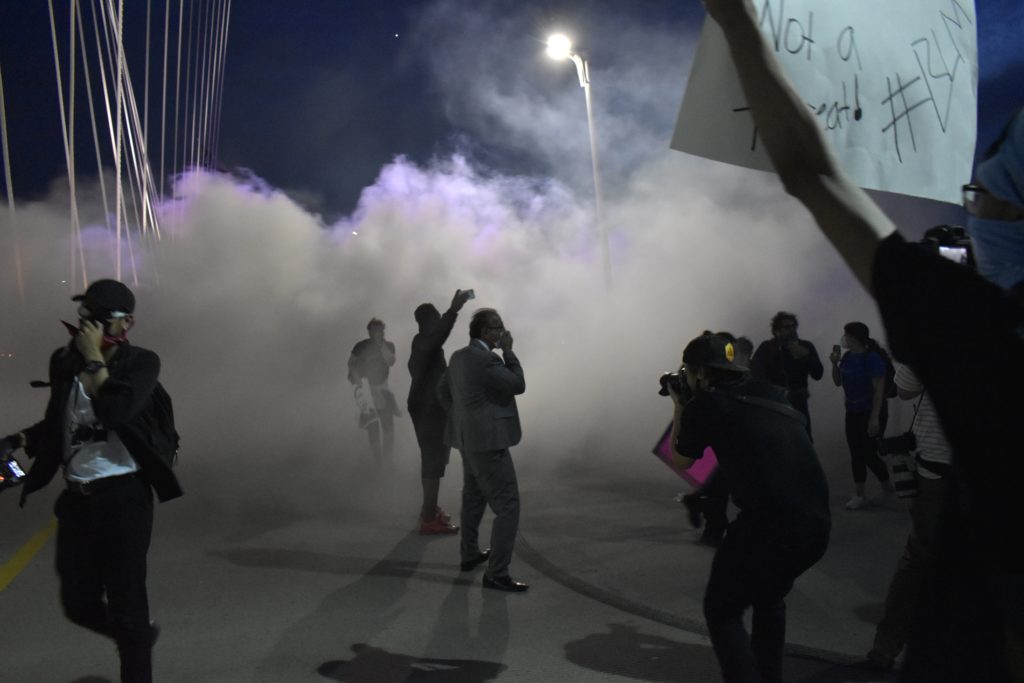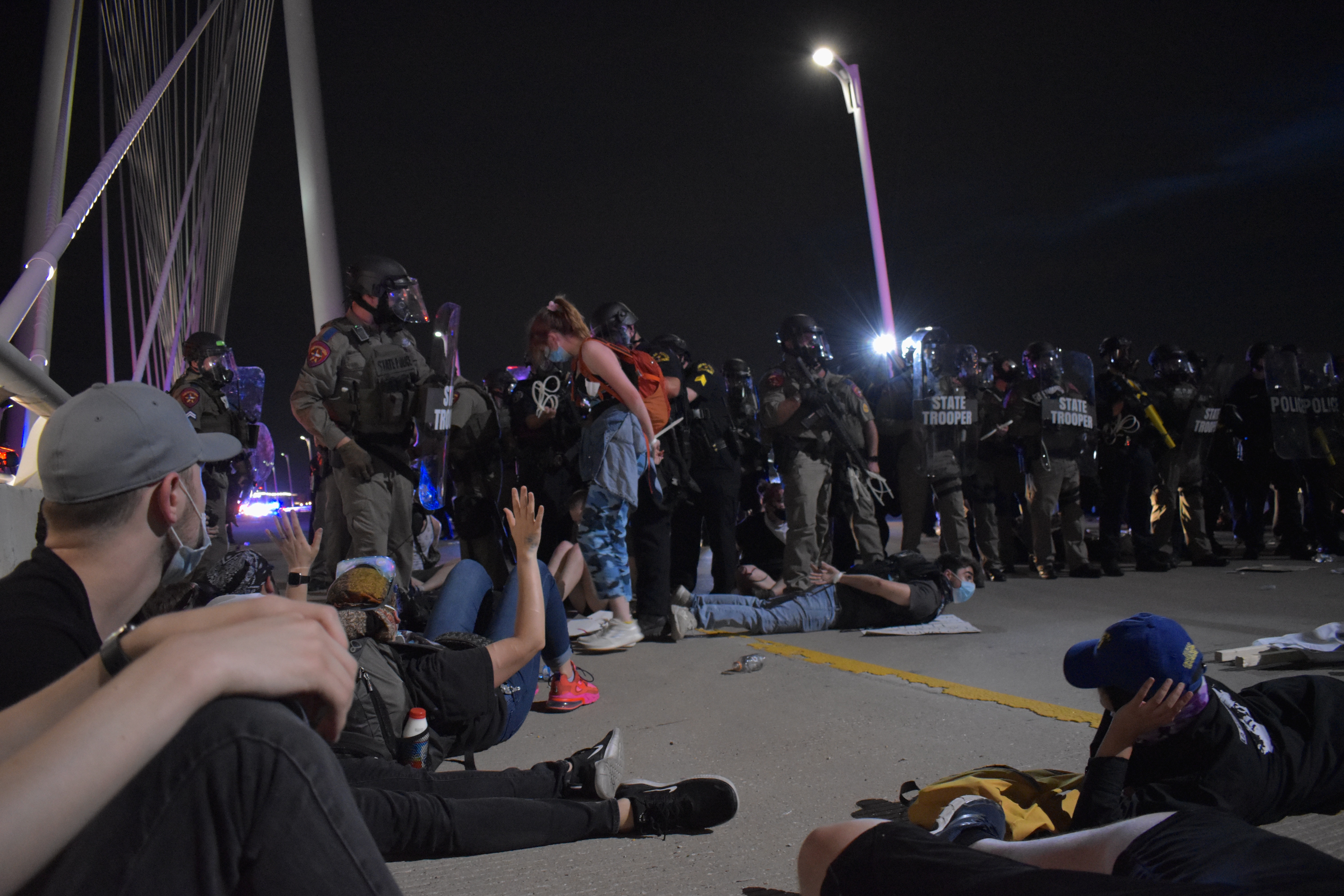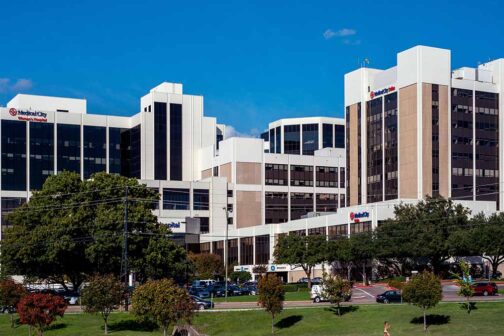On Monday night, the Dallas Police Department detained 674 peaceful protesters on the Margaret Hunt Hill Bridge. I was one of them.
I knew it could happen. I had seen nonviolent protesters in virtually every state get gassed, shot at, beaten, and arrested over the weekend. But I needed to be there with my fellow Dallas comrades. I was raised in Plano, attended the UNT, and have lived in Dallas since 2015.
During Sunday’s march through downtown, more than 125 people were arrested largely for curfew violations. Two officers are being investigated for “use-of-force incidents” over the weekend, one involving a protester who lost an eye after being shot with a sponge round. Still, prior to Monday night, I had never been cited for anything more than a speeding ticket. I wanted to march to change police militarization and systemic racism, not my permanent record.
It’s funny, I remember thinking as my wrists bruised and my back ached during four hours of confinement, because our entire protest was specifically meant to play by their rules.
We met before curfew outside Dallas police headquarters, where organizers revealed our intentions. Because the curfew was instituted in a zone around the city’s core, we instead marched to the Frank Crowley Courts Building. It was located just outside those boundaries. We used sidewalks and heeded pedestrian signals. I was grappling with uncomfortable feelings toward the lead organizer, a man named Dominique Alexander who represents an organization called Next Generation Action Network. In 2019, Alexander was indicted for continuous family violence. (His partner was treated for injuries at a hospital but later said she would not testify against him.) But organizers inherently do not define a movement, which consists of many people with similar, though not identical, shared beliefs.
At the courthouse, there was just and righteous messaging thundering through the speakers. Alexander and hundreds more protesters were already there. Alexander spoke passionately. He invited protesters to share unscripted messages of exhaustion and anger at the heavy burden our country puts on black people. It was suspicious how many state troopers calmly watching us across the street had zip ties across their chest, the stark white plastic contrasting against camouflage body armor.
I briefly wondered about Alexander’s intentions when he had us chant the phone number we should call if arrested. But the police presence was non-threatening. Very few officers held visible weapons or riot gear. Shortly after the 7 p.m. curfew, local media members confirmed with the city that we were lawfully assembling outside of the zone. Around 8 p.m., Dallas City Councilman Adam Bazaldua joined us with a supportive speech advocating for change. A city councilman wouldn’t publicly participate in an illegal event, right? The city had made a conscious choice to shut down the street in front of us. When we organized to march a half hour later, it was hard not to think it was sanctioned.
Much later that night, I learned Alexander had an agreement with Dallas County Judge Clay Jenkins that we would be safe at the courthouse until 10 p.m. If we left its premises, Jenkins couldn’t guarantee our safety. That was never communicated to us. Don’t take this to mean we were naive.
I’ve been politically active in various manners for two years. I wore dark clothes and gloves and handed out protective eyewear I had bought. Others mixed baking soda with water if we needed to relieve burning eyes. Many carried medical supplies. But I felt cautiously comfortable when Alexander led us to march around 8:30 p.m. and we stepped onto the street. I can only imagine others — high schoolers, parents, obvious first-time protesters — must have been even more trusting.
We marched one block north, past a few police who were silently observing us. We found the next intersection blocked on two sides. Using the loudspeakers on their vehicles, officers offered vague instructions. You are obstructing a public roadway, they warned about the street they had blocked off an hour prior. You are breaking the law. But they also told us, Continue moving and do not approach the police. They had not blocked off the westbound ramp onto the Margaret Hunt Hill Bridge. We marched up the ramp.
In a Tuesday press conference, Dallas Police Chief U. Reneé Hall told reporters that protesters were warned marching onto the bridge would lead to arrest. I never heard that warning. I talked to more than a dozen protesters that night and the following day who never heard that warning. Journalists embedded within our march say they never heard that warning. Perhaps a brief warning was issued. If it was, our march was almost 700 strong spread out over hundreds of feet. At some point, you’re just following the pack.
Hall now says the 674 detainees — me included — are facing at-large charges of obstructing a highway, a class-B misdemeanor. (Dallas County District Attorney John Creuzot has not yet indicated whether he will prosecute.) That offense occurs when one “obstructs a highway … to which the public or a substantial group of the public has access,” or when one “disobeys a reasonable request or order to move issued by a person the actor knows to be or is informed is a peace officer, a fireman, or a person with authority.” A separate group of 20 to 30 people who approached the bridge chanting from the west side were also fired upon and hit with smoke, according to Chase Beakley, a D Magazine contributor.
Hall says that the bridge was not closed to traffic when we marched up the ramp. I do not know if that is true. I do know that I saw flashing police lights on both sides of the bridge when I stepped onto it. I also know that I never saw moving or stranded vehicles on either the westbound side we occupied or the eastbound side we didn’t.

I do believe Hall lied at least once when she denied tear gas was used against us Monday night. (Hall has confirmed tear gas was used against protesters in multiple instances prior to Monday.) I asked a Dallas Police Department spokesperson on Wednesday whether tear gas was used on the bridge. He said, “Smoke was used to disperse the crowd.” It was not smoke. It was tear gas. I saw and smelled it. I heard anguished screams around me from those with burning eyes. We heard officers tell us they would not use “more” gas if we complied with them. We poured our baking-soda-and-water mixtures into swollen eyes to reduce the chemical effect that tear gas has when it binds with the human body’s TRPA1 and TRPV1 pain receptors, the same ones that make mustards and wasabi spicy. Tear gas has been measured to be more than 10,000 times stronger than those ingredients.
It is a hopeless fear you feel when a line of armed humans approaches you with no way to escape. As soon as we fully marched onto the bridge, police officers clad in riot gear approached us from the west side. Armored vehicles enclosed us on the bridge’s other end. It was at least 30 feet to the ground below us. This technique is called kettling. It strips away the protester’s agency to disperse peacefully by entrapping them in an enclosed space.
I had barely stepped onto the bridge when I feared I knew what would happen. When the police line advanced, we yelled at those panicking around us to remain calm and not run. We would only hurt ourselves that way. Instead, we knelt. We put our hands up. I think we started chanting, “Don’t shoot.” Local reporters attest we had not committed a single act of violence or destruction the entire night. Moments later, they opened fire on us.
I was lucky. I avoided the gas that was largely blown off the bridge by a divine northern wind and wasn’t struck by the “less than lethal” bullets indiscriminately blasted into the crowd. Those who were hit showed me massive blue-and-black splotches on their skin where they had been struck. I saw at least one bloodied face and heard stories about others. When I was restrained, my officer assured me he left a little room. I can only assume why he treated me better than others. My wrists still bruised while I sat in the plastic restraints for nearly four hours, but many of those around me had numb fingers and pinched blood vessels.
I thought about many things in the coming hours. I thought about Alexander, our organizer, who either willfully led us onto the bridge believing this would happen or stupidly didn’t realize that the most important rule of protesting is avoiding enclosed spaces. I thought about the high schooler having a panic attack while she screamed she couldn’t lose her college scholarships.
I thought about a protester not far away from us who required medical help after having a seizure about a half hour into his detainment. I thought about the conference call President Trump had Monday morning with state governments demanding harsher treatment of protesters. I thought about the favorite joke officers kept telling us: You’re all going to jail tonight. Actually, they didn’t know any more than we did. What had been chaos quickly morphed into confusion. No one knew if we would be jailed, if we would be charged, what those charges would be, or, frankly, why this was even happening.
Our confinement did become more relaxed each passing hour. We formed communities with those restrained around us, sharing circulation tips and reassurance and mindless conversation. We were eventually allowed to stand up, stretch out, and walk around. With a few exceptions, we weren’t reprimanded for using our phones if we could reach them or giving interviews to media members who stood across the bridge’s median from us with television cameras. Some of us even smoked cigarettes. (I am still impressed we managed that with our constraints.)

Eventually, officers started reapplying zip ties that had been put on too tightly. We even bonded with a Dallas Police officer who was stationed near us. He made the mistake of telling us his name was J.J., and we called out his name for hours afterward, asking for mundane favors. I thought J.J. seemed like a reasonable guy. It wasn’t actively his fault he was deployed in military-grade equipment to brutally detain nearly 700 peaceful protesters for hours.
In fact, it is many people’s faults over many years. It cannot be excused or defended. Experts say police militarization does nothing to increase public safety. In 1990, as part of its War on Drugs, the Bush administration created a program to loan excess military equipment directly to civilian law enforcement agencies. It includes mundane items like furniture but also vehicles, aircraft, weapons, ammunition, and specialized warfare equipment.
In 1997, under President Clinton, it was upgraded and renamed the 1033 program. Agencies could now permanently acquire the equipment free of charge after one year so long as the equipment got used. You can imagine that this country’s armed forces, with a defense budget larger than the next 10 countries’ defense budgets combined, is incentivized to constantly replace old equipment, just as civilian law enforcement agencies are incentivized to acquire and — so they don’t lose it after a year — use it. More than 8,000 agencies have received over $7.4 billion worth of property. Nearly every North Texas city has taken part, even specks like Dalworthington Gardens.
It struck me on that bridge that the uniformed peace officers — as they are referred to in the text of the misdemeanor I am charged with — might have actually outnumbered us. There were at minimum hundreds of officers, state troopers, and other agents representing various specialized units.
FBI agents were even present. How many millions of dollars did this night on the bridge cost the state of Texas? Think about the salaries, the overtime pay, the hundreds of vehicles involved, the circling helicopter surveillance, even the military-grade equipment used against us. Certainly not all of this was acquired through the 1033 program. (Hazardous material cannot be obtained through this program and tear gas is internationally banned in war.)
It makes you wonder about what else that money could pay for. And whether, if our police department hadn’t arrived armed as if we were enemy combatants, the night would have ever needlessly escalated.
I was one of the final protesters released Monday night. My zip ties were snipped around 1:30 a.m. It was unclear even then if I was being charged; they wrote my information on a paper slip. I was taken to the Frank Crowley Courts Building in a van driven by a lovely officer who brake-checked us twice after parking.
I finally went home. I ate dinner, responded to the more than 50 text messages I had received from panicked friends, read an hour’s worth of news coverage of our detainment, and passed out with my reading light still on, wearing the same clothes I wore on the bridge.
Then I went to another protest the next day.





